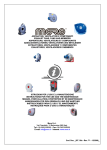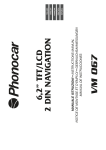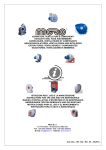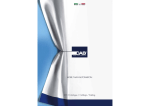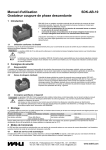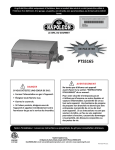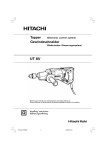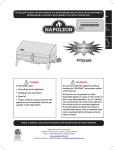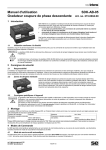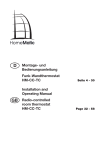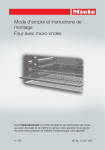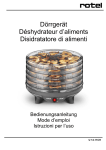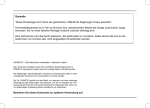Download instruction manual 090 arbeitsanleitung 090 manual de
Transcript
S.r.l. INSTRUCTION MANUAL 090 MANUAL DE INSTRUCCIONES 090 ARBEITSANLEITUNG 090 LIVRET D’INSTRUCTIONS 090 WARNING: Do not operate while the transformer is energized ADVERTENCIAS: Hay que manobriar fuera de tension WARNUNGEN: Schaltvorgänge bei spannungslosem transformator durchführen! AVIS: ne pas manœuvrer avec le transformateur en tension! Edi/Rev data attivazione: 01/00 30/01/2009 ENGLISH ESPAÑOL General information Chapter 1: Switching operation (to the end-user) Chapter 2: Assembly operations (for the manufacturer of transformers) Chapter 3: Treatment in the oven and / or under vacuum and lubrication Informaciónes generales Capítulo 1: Maniobra operacionale de conmutación (para el usuario final) DEUTSCH 10 16 6 Capítulo 2: Las operaciones de montaje (para el constructor de transformadores) 10 Capítulo 3: Tratamiento en horno y/o autoclave y lubrificación 16 Allgemeine auskunft Kap. 1: Operative Schaltvorgänge (für Endverbraucher) FRANÇAIS 6 Kap. 2: Montageanleitung (für Umschaltererbauer) Kap. 3: Behandlung im Ofen und/oder Autoklav und Schmierung 20 24 30 Général renseignements Chapitre 1: Manœuvre opérationnelle de commutation (pour l’utilisateur final) 20 Chapitre 2: Operations d’assemblage (pour le constructer de transformateurs) 24 Chapitre 3: Traitement en four et/ou autoclave et graissage 2 30 fig. 1.1 fig. 1.2 fig. 1.3 fig. 1.4 fig. 1.5 fig. 1.6 fig. 2.1 fig. 2.2 fig. 2.3 fig. 2.4 fig. 2.5 fig. 2.6 fig. 3.1 fig. 3.2 3 GENERAL WARNINGS MAIN CHARATERISTIC this is an off-circuit tap changers. It means all switching manoeuvre must be performed after disconnecting transformer by the electrical net opening the sectionalising switches, both HV and LV side, so transformer becomes off-circuit. DIMENSION All dimension reported in case of drawings attached are in millimetres (mm) TRANSFORMER OIL All our tap changers are suitable to work in oil immersed transformers according to standard IEC 60296. In case user need to use specific oil (silicon, synthetic or vegetal) it is necessary consulted CAPT technical office who verify the functionality of tap in all the mechanicals, electrical and chemical characteristics. INSULATION MATERIAL The insulating materials used are bakelite (paper laminates and phenoplastic resin) of “E” thermal class. GASKET Gasket supply in our tap changers and in our transmission drive handles are type NBR and they are suitable for oil transformer, indicate for temperature in oil between -25°C and +100°C and for temperature on air between -25°C and +40°C, according to IEC 60214-1/2. On request, we can supply tap changer with special rubber for low temperature till -60°C and for high temperature till +200°. These gaskets are suitable for oil transformer and they can be in HNBR, VITON, in Silicon rubber. They can be used in arctic or tropical conditions. DRYING TREATMENT Different drying treatment can be process by customer: oven, in a vacuum autoclave, vapour-phase or other. In this process is normally included tap changer too. The maximum temperature suggested by CAPT for our tap changers is 100°C-120°C for a time or 24÷36h. DRYING TREATMENT IN CASE OF BEVEL GEAR AND DRIVE HANDLE It is better to leave out from drying treatment the drive handle and bevel gear. In case it is impossible to leave them out, we suggest to strictly respect the temperature recommended when you need drive handle with micro switch for electrical lock or electrical position transmitter. ENGLISH WHEN CONTACT CAPT In the following cases please contact CAPT: s&ORTEMPERATURECONDITIONHIGHERLOWERTHENSUGGEST s&ORTEMPERATURECONDITIONHIGHERLOWERTHENSUGGEST s&ORHARDTEMPERATURECONDITIONSWITHPOSSIBILITYOFSNOWORSANDSTORMINGORINPOTENTIALSEISMICAREA 4 TAP CHANGER 090 The tap changer 090 is a linear tap changer which offers various possibilities of connections: bridge, linear, star and change-over voltage S/P o ∆/Y connections. The main characteristics are: its compactness, the simplicity of the installation, low temperature rise of the contacts. It is suited for use in mineral oil, silicone and synthetic oils. Voltage: Voltage tests to earth Rated voltage Tensione max kV kV kV kV 20 30 24 36 50 70 125 170 Industrial frequency 50 Hz ImpulsE 1/50 μS CUrrent: 10 A – 30 A – 60 A STANDARD REFERENCES: IEC60214-1 e IEC60214-2 &ORTHEINFORMATIONANDDETAILSISTOFOLLOWNOTFOUNDINTHISMANUALTHECLIENTISTOFOLLOWTHERULESOFTHE current International IEC60214-1 e IEC60214-2. WORKING TEMPERATURE The tap changer operates with oil-temperatures between – 25°C and +100°C (see IEC60214-1 4.1). DO NOT OPERATE WHILE TRANSFORMER IS ENERGISED! MAINTENANCE (for the end-user) The tap changer does not require special maintenance. If the tap changer remains unused in a single position for a long period of time (months) during the maintenance of the transformer and with the transformer de-energised, we recommend to first perform a series of operations on all the positions in order to clean the surface of the contacts. (see IEC60214-2 5.4.3 and 9.1.3) CHAPTER 1 – SWITCHING OPERATION (TO THE END-USER) DON’T PULL THE KNOB UP! To change the position, after having lifted up the clamp (locking-device) (see figure 1.2), you only have to rotate the knob without pulling it up and continue the operation up to the required new position, and then insert and lock the clamp (locking-device) inside the right position (see figure 1.3). Check that the 2 triangular arrows located on the knob and on the “positioning” ring correspond with each other. It is possible to remove the knob only if it is placed in the insert/extract mechanism because an antiextraction device is functioning (see figure 1.4). 5 ENGLISH (see figure 1.1) SAFETY PADLOCK The knob can be padlocked in any position by utilizing the appropriate rectangular hole on the positioning-ring and inserting the shackle of the padlock (6 mm max.) in the corresponding hollow space of the knob (see figure 1.5). The protection cap made of “Zama” (Zn + Al + Mg alloy), supplied on request, can be padlocked by utilizing the appropriate holes situated on the tongues external to the base of the cap (see figure 1.6). CHAPTER 2 – ASSEMBLY OPERATIONS (FOR THE MANUFACTURER OF TRANSFORMERS) The knob must be inserted only when the 2 milled centering parts are in alignment. One is positioned on the shaft and the other is positioned on the metallic section of the support (see figure 2.1) The lid of the transformer can vary in thickness from 2÷8 mm. The knob is self-adjusting and no thicknesswashers are necessary (see figure 2.2). The components must be inserted in the following order: 1. OR gasket ring 2. Positioning ring &IXINGNUT 4. Knob (see figure 2.3) Position the knob in the insert/extract position countermarked by 2 small arrows next to the number. 3 Example: for a knob with 5 positions, the insert/extract position is position 3 (see figure 2.4). When you reach the “desired” and correct position, you must press the knob down lightly until the attachment takes place (see figure 2.5). A soft “clacking” sound means the attachment has occurred. When the protective cap is requested, the transformer lid can vary in thickness from 2 + 6 mms. The knob is self-adjusting and no thickness washer is necessary. The components must be inserted in the following order: 1. OR gasket ring 2. Cap base 3. Positioning ring &IXINGNUT 5. Knob 6. Cap (see figure 2.6) CHAPTER 3. TREATMENT IN THE OVEN AND / OR UNDER VACUUM AND LUBRICATION It is recommended that the treatment is carried out at a maximum temperature between 100-120 °C for 24-36 hours (see figure 3.1) Contact our technical CAPT office when carrying out drying procedures at higher temperatures, or when carrying out “special” treatments. Lubrication and operations ENGLISH After the treatment, before using the tap changer, you must lubricate carefully all the fixed and moving contacts of the tap changer, or alternatively, place the tap changer together with its active part in an oil bath in the transformer-tank. Wait until the tap changer has come down to environment temperature before performing the first operation (see figure 3.2). 6 ADVERTENCIAS CARACTERISTICAS PRINCIPALES Este es un conmutador fuera de tensión . Esto signifíca que NO DEBE maniobrarse cuando el transformador está en presencia de tensión. DIMENSIONES Las dimensiones indicadas en caso de disegño anexo son todas en mm. ACEITE MINERAL PARA TRANSFORMADORES Todos los conmutadores fuera de tensión de nuestra producción se consideran conformes a funcionar en aceite para transformadores según las normas IEC 60296. Para otros aceites o líquidos aislantes como el aceite silicónico aceites sintéticos y aceites vegetales deben consultar el departamento técnico de CAPT para comprobar que las carácteristicas del conmutador sean conformes al intento. MATERIAL DE AISLAMIENTO El material aislante utilizado es Bakelite (láminas de papel en pura celulosa con resinas fenólicas) en clase térmica “E”. GUARNICIONES Las guarniciones estandard incluidas por CAPT para todos los mandos son del tipo NBR para el aceite de los transformadores y para temperaturas del líquido aislante comprendidas entre 25°C y +100°C y para temperaturas del aire comprendidas entre 25°C y +40°C, según las normas IEC 60214-1/2. Se pueden pedir guarniciones de varios tipos con mesclas que pueden soportar temperaturs màs bajas hasta -55°C y màs altas hasta +200°C. Estas guarniciones, siempre para aceite para transformadores y/o para aceites especiales , pueden ser del tipo HNBR, VITON, en GOMA SILICONICA, etcetera y pueden soportar las condiciones ambientales más extremas como clima tropical y clima ártico. TEMPERATURA DE SECADO En el proceso de secado de la parte activa del transformador, por parte de los constructores, se utilizan varios metodos: tratamientos en horno al vacío en autoclave, vapour-phase y otros. En este proceso usualmente se incluye el conmutador también. La temperatura máxima que CAPT recomienda para sus conmutadores es de 100;120°C durante un periodo máximo de 24÷36h. CONTACTAR LA CAPT Les rogamos que contacten nuestros técnicos en los siguientes casos: s%NCASODETEMPERATURASOTIEMPOSDESECADOSUPERIORESALOSINDICADOSENLEPRECEDENTEPARRAFO s 0ARA CLIMAS PARTICOLARES POSIBLES TEMPESTADES DE VIENTO O ARENA ZONA SÓSMICAS CONDICIONES ambientales extremas. 7 ESPAÑOL PROCESO DE SECADO CON TRANSMISIONES O MANDOS Es mejor relizar este proceso con el conmutador montado pero sin transmisiones y mandos. En el caso de que esto sea imposible es importante no superar los valores de tratamiento ya referidos. Cuando los mandos son completos de micro-interruptores para el bloqueo eléctrico de los seccionadores del transformador y/o para la transmisión a distancia de las posiciones o de otros componentes eléctricos se prefiere efectuar el proceso de secado del conmutador sin los mandos mismos; CONMUTADOR 090 Se trata de un conmutador lineal con varias posibilidades de conexión: de regulación trinquete, de punto fijo, de estrella y cambio tensión S/P ou ∆/Y. Sus características principales son: la compacidad, la facilidad de instalación, el bajo incremento de temperatura de los contactos. Se adapta para el uso en aceite mineral, en liquido de silicona, en aceites sintéticos. Tensiones: Tensiones de prueba hacia masa. Tensión nominal Tensión máxima &REQUENCIAIND 50 Hz Impulso 1/50 μS kV kV kV kV 20 30 24 36 50 70 125 170 Intensidades: 10 A – 30 A – 60 A NORMATIVA DE REFERENCIA: IEC60214-1 e IEC60214-2 Aunque no está explícitamente declarado en este manual, siguen siendo válidas las prescripciones de las vigentes normativas internacionales IEC60214-1 y IEC60214-2. TEMPERATURA DE EJERCICIO Las maniobras del conmutador se entienden para las temperaturas del aceite que van desde -25°C a +100°C (Véase IEC60214-1 4.1) NO MANIOBRAR CON EL TRANSFORMADOR EN TENSIÓN ! EL MANTENIMIENTO ( para el usuario final) El conmutador no requiere un mantenimiento especial. Si el conmutador permanece fijo en una misma posición durante mucho tiempo (meses) durante el mantenimiento del transformador y con el transformador fuera tensión, se recomienda efectuar una serie de operaciones sobre todas las posiciones, para limpiar la superficie de los contactos. (Véase IEC60214-2 5.4.3 y 9.1.3). Capítulo 1 – Maniobra operacionale de conmutación (para el usuario final) NO TIRAR HACIA ARRIBA EL MANDO! ESPAÑOL (véase figura 1.1) Para cambiar de posición, después de haber llevantado el gancho de bloque (véase figura 1.2), SOLAMENTE hay que dar vuelta al mando, sin tirar hacia arriba, hasta alcanzar la posición deseada. Pues se fija de nuevo el gancho de bloque a su posición de salida. (véase figura 1.3) Controlar que las dos flechas triángulares colocadas sobre el mando y sobre el anillo de posición sean correspondientes. En una posición diferente de la de inserción/extracción, no es posible quitar el mando porque está en acción el dispositivo antiextracción (véase figura 1.4). 8 El cierre con candado El comando del conmutador puede cerrarse con candado en cualquier posición usando agujero rectangular dispuesto sobre el anillo de posición, introduciendo el arco del candado (máximo 6 mm) en la cavidad correspondiente del mando (véase figura 1.5).También el capuchón de protección en aleación de cinc, aluminio, magnesio, bajo pedido del cliente, puede ser cerrado candado usando los agujeros dispuestos en las lengüetas externas al capuchón y a la base. (véase figura 1.6) Capítulo 2 – Las operaciones de montaje (para el constructor de transformadores) El mando debe ser introducido cuando se verifica la condicción de alineación entre las dos fresadoras centradas colocadas una sobre el árbol y la otra sobre la parte metálica del soporte (véase figura 2.1). El espesor de la tapa del transformador puede tener un espesor variable de 2÷8 mm. El mando se regla automaticamente sin la inserción de arendelas (véase figura 2.2). La secuencia de inserción de los componentes son: 1. Guarnición OR 2. Anillo de posición 3. Tuerca de bloque 4. Mando (véase figura 2.3) Introducir el mando en la posición de inserción/extracción marcada por dos flechas pequeñas a lado del número. 3 Ejemplo: mando a 5 posiciones, la posición de inserción/extracción es la pos. 3 (véase figura 2.4) Cuando se llega a la posición deseada y correcta, pulsar ligeramente el mando hacia bajo, hasta el enganche completo (véase figura 2.5). Un ligero ruido “clack” confirma que ocurriò el enganche. Cuando està pedido el capuchón de protección, el espesor de la tapa del transformador puede tenir un espesor de 2÷6 mm. El mando se regla automáticamente sin necesidad de arendelas. La secuencia de inserción de los componentes son: 1. Guarnición OR 2. Base del capuchón 3. Anillo de posición 4. Tuerca de bloque 5. Mando 6. Capuchón (véase figura 2.6) Lubrificación y operaciones Después del tratamiento, antes de maniobrar el conmutador, lubrificar cuidadosamente los contactos fijos y móviles del conmutador o introducir el conmutador, junto a la parte activa, en baño del aceite en la caja del conmutador. Esperar que el conmutador alcance la temperatura ambiente y después realizar la primera operación (véase figura 3.2). 9 ESPAÑOL Capítulo 3 Tratamiento en horno y/o autoclave y lubrificación Se aconseja realizar el tratamiento a una temperatura máxima de 100÷110°C (véase figura 3.1). En caso de procesos de secado con temperaturas más altas o tratamientos especiales, ponerse en contacto con la oficina técnica CAPT. WARNUNGEN HAUPTMERKMALE Es handelt sich hierbei um einen spannungslosen Umschalter. Dieses bedeutet, dass er NICHT betätigt WERDEN$!2&WENNSICHDER4RANSFORMATORUNTER3PANNUNGBElNDET DIMENSIONEN Die auf den folgenden Seiten aufgeführten Dimensionen sind alle in mm ausgedrückt. MINERALÖL FÜR TRANSFORMATOREN Alle spannungslosen Umschalter unserer Produktion sind dazu geeignet, im Öl eingetaucht zu funktionieren, soweit es sich um Transformatoren handelt, die mit der Vorschrift IEC 60296 übereinstimmen. &àRANDERE¾LEODER)SOLIERmàSSIGKEITENWIE3ILIKONÚLSYNTHETISCHES¾LUND6EGETALÚLMUSSMANSICHAN DASTECHNISCHE"àRODER&IRMA#!04WENDENUMDIE%IGENSCHAFTENDES5MSCHALTERSDIESBEZàGLICHZU überprüfen. ISOLIERUNGSMATERIAL Das verwendete Isolierungsmaterial ist Bakelit (Papierlaminate aus reiner Zellulose mit Phenolharz) in Thermoklasse “E”. DICHTUNGEN $IEVONDER&IRMA#!04FàRALLE3TEUERUNGENGELIEFERTEN3TANDARDDICHTUNGENGEHÚRENZUM4YP."2GEEIGNETFàRDAS4RANSFORMATORENÚLUNDFàR4EMPERATURENDER)SOLIERmàSSIGKEITZWISCHENª#UNDª# und für Lufttemperaturen zwischen -25°C und +40°C gemäß der Vorschrift IEC 60214-1/2. Aus Wunsch KÚNNENUNTERSCHIEDLICHE$ICHTUNGSTYPENMIT-ISCHUNGENGELIEFERTWERDENDIEFàRNIEDRIGERE4EMPERATURENBISZUª#UNDHÚHERE4EMPERATURENBISZUª#GEEIGNETSIND$IESE$ICHTUNGENDIEFàRDAS 4RANSFORMATORENÚLUNDODERFàRSPEZIELLE¾LEGEEIGNETSINDKÚNNENZUM4YP(."2ODER6)4/.GEHÚREN sowie aus SILIKONKAUTSCHUK sein usw. und sind in der Lage, die extremsten Umweltbedingungen wie das tropische Klima oder das arktische Klima auszuhalten. TROCKNUNGSTEMPERATUR Während des Trocknungsprozesses des aktiven Teiles des Transformators werden seitens der Hersteller unterschiedliche Methoden verwendet; Behandlungen im Ofen, Vakuum in Autoklaven, Dampfphasen und andere Methoden. Dieser Prozess schließt normalerweise auch den Umschalter ein. Die von CAPT für ihre EIGENEN5MSCHALTEREMPFOHLENE(ÚCHSTTEMPERATURLIEGTZWISCHENª#UNDª#FàREINEMAX$AUER von 24÷36 Stunden. DEUTSCH TROCKNUNGSPROZESS MIT VORGELEGEN ODER STEUERUNGEN Es wird empfohlen, diesen Prozess mit montiertem Umschalter, aber ohne Vorgelege und Steuerungen durchzuführen. &ALLSDIESESNICHTMÚGLICHISTSOLLTEMANDIEOBENAUFGEFàHRTEN"EHANDLUNGSWERTENICHTàBERSCHREITEN Wenn die Steuerungen mit Mikroschaltern zur elektrischen Blockierung der Trennschalter des Transformators UNDODERZUR&ERNSTEUERUNGDER0OSITIONENODERANDERERELEKTRISCHER+OMPONENTENVERSEHENSINDISTES empfehlenswert, den Trocknungsprozess des Umschalters ohne die Steuerungen durchzuführen; DIE FIRMA CAPT KONTAKTIEREN )NDENFOLGENDEN&ËLLENBITTENWIR3IEDARUMUNSERE4ECHNIKERZUKONTAKTIEREN s)M&ALLEVON4ROCKNUNGSTEMPERATURENODERZEITENDIEàBERDENIMVORHERIGEN!BSCHNITTAUFGEFàHRTEN Werten liegen; s)M&ALLEVONBESONDEREM+LIMAMÚGLICHEN3ANDSTàRMEN%RDBEBENGEBIETENEXTREMEN5MWELTBEDINgungen. 10 UMSTELLER 090 %S HANDELT SICH UM EINEN HORIZONTALUMSTELLER MIT VERSCHIEDENEN 6ERBINDUNGSMÚGLICHKEITEN +LINKENEINSTELLUNG &IXPUNKT 3TERN UND 7ECHSELSPANNUNG 30 O ∆/Y. Die Haupteigenschaften sind: kompakte Abmessung, leichte Montage, niedrige Übertemperatur der Kontakte. Der Umsteller kann sowohl IN-INERALUND3ILIKONÚLALSAUCHIN"ETRIEBSÚLEINGESETZTWERDEN. Spannungen: Nennspannung (ÚCHSTSPANNUNG kV kV 20 30 24 36 Prüfspannung Gegen Masse Ind. Betriebsfrequenz Impuls 1/50 μS 50 Hz kV kV 50 70 125 170 3TRÚMSTËRKEN!n!n! NORMEN: IEC60214-1 e IEC60214-2 Obwohl es in diesem Buch nicht klar ausgedrückt worden ist, sind die internationalen geltenden Vorschriften IEC60214-2 hier gültig. PRÜFTEMPERATUR Die Schaltvorgänge werden in Öltemperatur zwischen – 25 °C und + 100 °C durchgeführt (Siehe IEC60214-1 4.1). SCHALTVORGÄNGE BEI SPANNUNGSLOSEM TRANSFORMATOR DURCHFÜHREN! INSTANDHALTUNG (für Endverbraucher) Der Umsteller braucht keine besondere Wartung. Wenn der Umsteller in der selben Position (d.h. stillliegend für Monate) bleibt, empfiehlt es sich, während der Wartung des Transformators und bei Spannungslosem Transformator, eine Reihe von Schaltvorgängen in allen Positionen durchzuführen, um die Öberfläche der Kontakte zu reinigen. (sehen IEC60214-2 5.4.3 und 9.1.3) Kap. 1 – Operative Schaltvorgänge (für Endverbraucher) DEN GRIFF NICHT NACH OBEN ZIEHEN! .ACHDEMSIEDENSPERRBàGELGEÚFFNETHABENKÚNNENSIE%).&!#(DENGRIFFINDIEGEWàNSCHTEPOSITION drehen (siehe Bild 1.2), und darauf den sperrbügel wieder fixieren (siehe Bild 1.3). Überprüfen, dass die zwei Dreieckpfeilen auf dem Griff und auf dem Positionsring entsprechend sind. Der Griff kann nur in der Ein-/ Ausbaustellung herausgezogen werden, weil sonst eine Auszugsverriegelung in Gang gesetzt ist (siehe Bild 1.4). 11 DEUTSCH (siehe Bild 1.1) DIE SPERRUNG MIT EINEM VORHÄNGESCHLOSS Die Umstellerposition kann in jeder Position mit einem Vorhängeschloss gesperrt werden. Man muss das eigens dazu bestimmtes Rechteckloch auf den Positionsring verwenden und das Vorhängeschloss (max. 6 mm) in den Hohlraum des Griffes stecken (siehe Bild 1.5). Auch die Schutzabdeckung aus einer Legierung aus Zink, Aluminium und Magnesium, die auf Wunsch lieferbar ISTKANNAUCHVERRIEGELTWERDEN(IERZUBENUTZTMANDIE,ÚCHERAUFDENEXTERNEN3CHUTZABDECKUNGSFEDERN (siehe Bild 1.6) KAP. 2 – MONTAGEANLEITUNG (FÜR TRANSFORMATORENHERSTELLER) Der Schaft kann nur eingefügt werden, wenn die beiden Zentrierbohrungen ausgerichtet sind. Einer wird auf dem Schatt und der andere auf dem Isolierträger positionert (siehe Bild 2.1). Die Stärke der Transformatorendeckels kann eine veränderliche Stärke von 2 ÷ 8 mm haben. Der Griff ist selbstregelnd, ohne Distanzscheibe einzufügen (siehe Bild 2.2). Die Komponenten werden wie folgt eingeführt: 1.O-Ring-Dichtung 2.Positionsring 3.Befestigungsmutter 4.Griff (siehe Bild 2.3) Das Einfügen des Griffes erfolgt in der Ein-/ Ausbaustellung, die durch zwei kleinen Pfeile neben der Nummer gekennzeichnet ist. 3 Zum Beispiel: Griff mit 5 Positionen, die Ein-/ Ausbaustellung ist die Nr. 3 (siehe Bild 2.4). Wenn die gewünschte und richtige Position erreicht ist, drücken sie den Griff ein bisschen nach unten, bis Zur kompletten Einrastung (siehe Bild 2.5). Mit einem Clack wird die Einrastung bestätigt. Bei bestellung einer Schutzabdeckung, kann die Stärke der Transformatorendeckels 2-6 mm betragen. $ER'RIFFISTSELBSTREGELNDUNDBENÚTIGTKEINE$ISTANZRINGE Die Komponenten werden wie folgt eingeführt: 1. O-Ring-Dichtung 2. Basis der Kappe 3. Positionsring 4. Befestigungsmutter 5. Griff 6. Kappe (siehe Bild 2.6) KAP. 3 BEHANDLUNG IM OFEN UND/ODER AUTOKLAV UND SCHMIERUNG %MPFOHLENWIRDEINE(ÚCHSTTEMPERATURVONª#STUNDEN (siehe Bild 3.1) Man muss die technische Abteilung CAPT kontaktieren, wenn es besondere Behandlungen und 4ROCKNENPROZEDURENMIT(ÚCHSTTEMPERATURENGIBT DEUTSCH Schmierung und Schaltvorgänge .ACHDER"EHANDLUNGVORDEM3CHALTVORGANGSCHMIEREN3IEAUFMERKSAMDIEBEWEGLICHENUND&IXKONTAKTE des Umstellers oder tauchen den Umsteller, zusammen mit dem aktiven Teil, im Öl ein. Warten Sie bis der Umsteller eine normale Temperatur erreicht hat und leiten. Sie dann den ersten Schaltvorgang ein (siehe Bild 3.2). 12 AVIS CARACTERISTIQUES PRINCIPALES Celui-ci est un commutateur hors tension. Cela signifie qu’il NE DOIT être manœuvré quand le transformateur est en présence de tension. DIMENSIONS Les dimensions écrites dans les pages suivantes sont toutes exprimées en mm. HUILE MINERAL POUR TRANFORMATEURS Tous les commutateurs hors tension de notre production doivent être considérés aptes à fonctionner immergés dans l’huile pour transformateurs en accord avec la norme IEC 60296. Pour d’autres huiles ou liquides isolants comme huile siliconé, huile synthétique et huiles végétaux on doit consulter le service technique CAPT pour vérifier les caractéristiques du commutateur apte au but . MATERIEL ISOLANT Le matériel isolant utilisé est la Bakélite (laminés de papier en cellulose pure avec (résines fénoliques) en classe thermique “E”. JOINTS Les joints standard fournies par CAPT pour toutes les commandes sont du type en NBR (caoutchouc) aptes pour l’huile des transformateurs et pour les températures du liquide isolant comprises entre -25°C et +100°C et pour la température de l’air comprises entre -25°C et +40°C, selon la norme IEC 60214-1/2. Sur demande nous pouvons vous fournir des différents types de joints avec mélanges aptes aux températures plus basses jusqu’à -55°C et plus élevées jusqu’à +200°C. Ces joints, toujours aptes à l’huile pour transformateurs et/ou aux huiles spéciaux, peuvent être du type HNBR, VITON, en GOMME SILICONE, etcetera et elles peuvent supporter les conditions ambiantes plus extrêmes comme le climat tropical et le climat arctique. TEMPERATURE DE SECHAGE Dans le procès de séchage de la partie active du transformateur, de la part des constructeurs, on utilise des méthodes différentes; traitements dans le four, sous vide en autoclave, phase vapeur et d’autres. Dans ce procès il est habituellement inclut aussi le commutateur. La température maximale recommandée par CAPT pour ses commutateurs est de100°÷120°C pour une période maximale de 24÷36h. PROCES DE SECHAGE AVEC RENVOIS OU COMMANDES Il est préférable que ce processus soit réalisé avec le commutateur monté mais sans renvois et commandes. Au cas où il était impossible nous vous conseillons de ne pas dépasser les valeurs de traitements indiquées par-dessus. Quand les commandes sont complètes de micro-interrupteurs pour le bloque électrique des sectionneurs du transformateur et/ou pour la transmission remote des positions ou des autres composants électriques il est préférable de effectuer le processus de séchage du commutateur sans les mêmes commandes; FRANÇAIS CONCTACTER CAPT Dans ces cas là nous vous prions de bien vouloir consulter nos techniciens: s!UCASOáLESTEMPÏRATURESOULESTEMPSDESÏCHAGESOIENTSUPÏRIEURESÌCEQUIESTINDIQUÏDANSLE paragraphe précédent; s0OURDESCLIMATSPARTICULIERSDESPOSSIBLESTEMPÐTESDESABLEZONESSISMIQUESCONDITIONSDUMILIEU extrêmes. 13 COMMUTATEUR 090 Il s’agit d’un commutateur linéaire avec différentes possibilités de branchement: à réglage cliquet, à point fixe, à étoile et changement tension S/P ou ∆/Y. Ses caractéristiques principales sont: la compacité, la facilité d’installation, la basse sur-température des contacts. Il est adapté pour emploi en huile minérale, en liquide à base de silicone, en huiles synthétiques. Tensions: Tensions d’épreuve vers masse Tension nominale Tension maximale kV kV kV kV 20 30 24 36 50 70 125 170 &REQUÏNCEIND Impulsion 1/50 μS 50 Hz Courants: 10 A – 30 A – 60 A NORMAS DE REFERÊNCIA: IEC60214-1 e IEC60214-2 Même s’il n’est pas expréssement declaré dans ce livret, les prescriptions des réglementations internationales en vigeur IEC60214-1 et IEC60214-2. e IEC60214-2 restent valables. TEMPÉRATURE DE MARCHE Les manœuvres du commutateur s’entendent pour des températures d’huile comprises entre -25°C et +100°C (Voir IEC60214-1 4.1). NE PAS MANŒUVRER AVEC LE TRANSFORMATEUR EN TENSION! ENTRETIEN ( pour l’utilisateur final) Le commutateur ne nécessite pas un entretien spécial. Si le commutateur reste ferme dans une seule position pour longtemps (mois) pendant l’entretien du transformateur et avec le transformateur hors tension, nous recommandons d’exécuter une série de manœuvres sur toutes les positions, pour netttoyer la surface des contacts. (Voir IEC60214-2 5.4.3 et 9.1.3) CHAPITRE 1 - MANŒUVRE OPÉRATIONNELLE DE COMMUTATION (POUR L’UTILISATEUR FINAL) NE PAS TIRER VERS LE HAUT LA POIGNÉE! FRANÇAIS (voir figure 1.1) Pour changer de position, après avoir soulevé la piognée de blocage (voir figure 1.2), on doit seulement tourner, sans tirer vers le haut, la poignée jusqu’à rejoindre la position desirée et repositionner le dispositif de blocage à la position de fermeture. (voir figure 1.3) Contrôler que le deux flèches triangulaires posées sur la poignée et sur la bague de position soient correspondantes. Dans une position différente de celle d’introduction/extraction, il n’est pas possible d’ôter la poignée parce que le dispositif antiextration est en marche (voir figure 1.4). 14 Fermeture avec cadenas La commande du commutateur peut être fermée avec cadenas à n’importe quelle position utilisant le trou rectangulaire correspondant sur la bague de position et en introduisant l’arc du cadenas (max 6 mm) dans la cavité correspondante de la poignée (voir figure 1.5) Même la corne de protection en alliage de zinc, aluminium et magnésium, livrée sur demande, peut être fermée avec cadenas en utilisant les trous prédisposés sur les languettes extérieures à la corne et à la base (voir figure 1.6) CHAPITRE. 2 – OPERATIONS D’ASSEMBLAGE (POUR LE CONSTRUCTER DE TRANSFORMATEURS) La poignée doit être introduite quand les deux fraisages de centrage posées une sur l’arbre et l’autre sur la partie métallique du support sont alignés (voir figure 2.1). La surface du transformateur peut avoir une épaisseur variable entre 2÷8 mm. La poignée se régle automatiquement sans insérer aucune rondelle d’épaisseur (voir figure 2.2). La suite d’introduction des composants est: 1.Garniture OR 2.Bague de position 3.Écrou de ablocage 4.Poignée (voir figure 2.3) Introduir la poignée dans la position d’introduction/extraction marquée par 2 petites flèches à côté du nombre. 3 Exemple: poignée à 5 positions: la position d’introduction/extraction est la pos. 3 (voir figure 2.4). Quand on a rejoint la position desirée et correcte, presser légèrement la poignée verso le bas, jusqu’au complet encliquetage (voir figure 2.5). Un léger bruit “clack” confirme que l’encliquetage s’est verifié. Quand on commande la corne de protection, la surface du transformateur peut avoir une épaisseur variable entre 2÷6 mm. La poignée se régle automatiquement sans insérer aucune rondelle d’épaisseur. La suite d’introduction des composants est: 1. Guarniture OR 2. Base du corne 3. Bague de position 4. Écrou de ablocage 5. Poignée 6. Corne (voir figure 2.6) Graissage et manœuvres Après le traitement, avant de manœuvrer le commutateur, graisser soigneusement les contacts fixes et mobiles du commutateur ou introduir le commutateur, avec la partie active, à bain d’huile dans la surface du commutateur. Attendre que le commutateur soit retourné à température ambiante et ensuite effectuer la première manœuvre (voir figure 3.2). 15 FRANÇAIS CHAPITRE 3 - TRAITEMENT EN FOUR ET/OU AUTOCLAVE ET GRAISSAGE On conseille d’exécuter le traitement à une température maximale de 100÷120°C pour 24-36 heures. (voir figure 3.1) En cas de procédés d’essication avec températures supérieures ou traitements spéciaux, contacter le bureau technique CAPT. C.a.p.t. srl - Società con socio unico 1° Plant: Via Postale Vecchia, 17 - 36070 - Trissino - VI - Italy 2° Plant: Via Arzignano, 43 - 36070 - Trissino - VI - Italy tel. +39 0445 962297 fax +39 0445 490606 E-mail: [email protected] www.capt.it
















